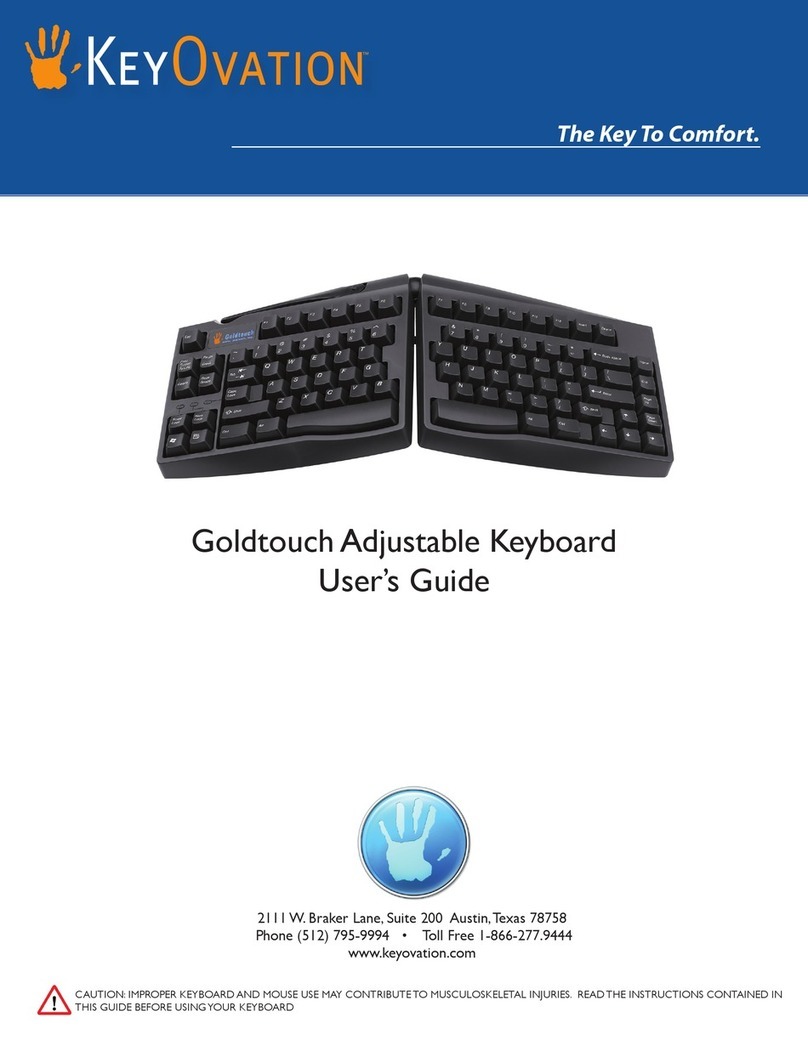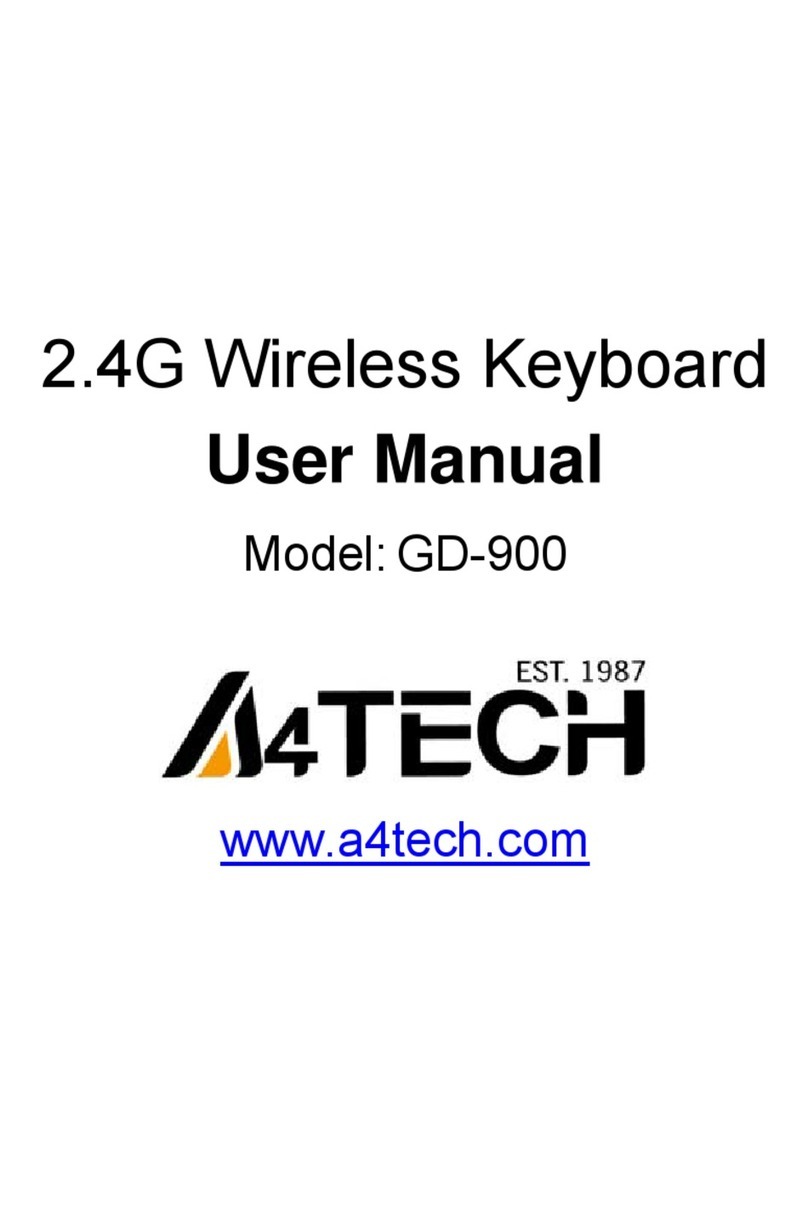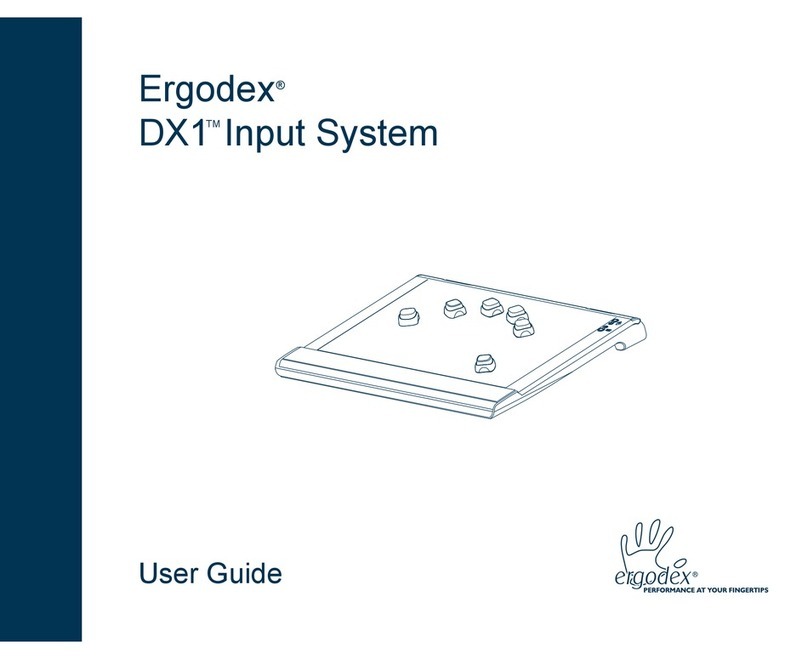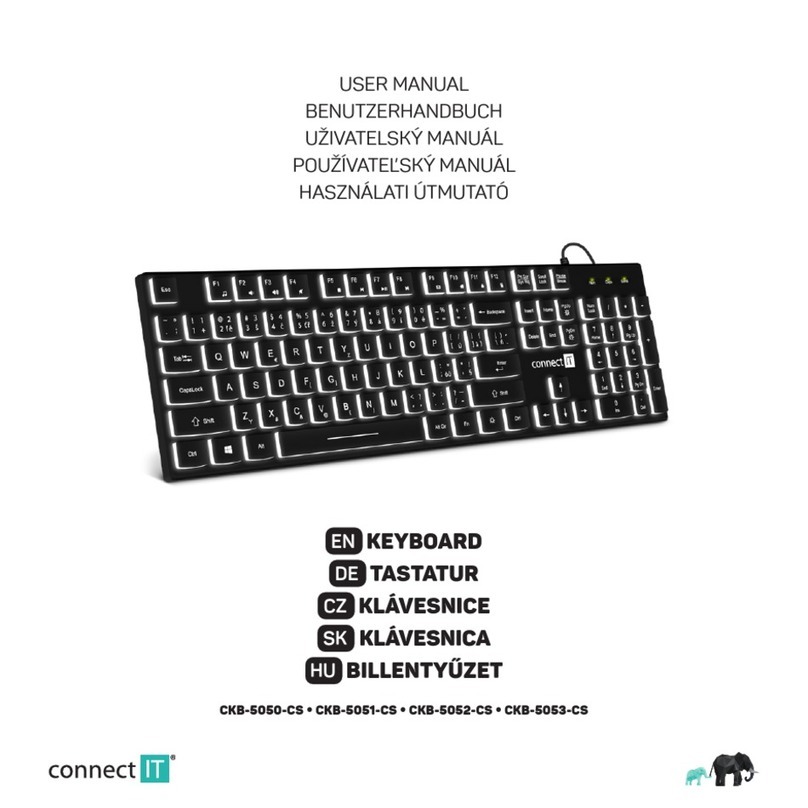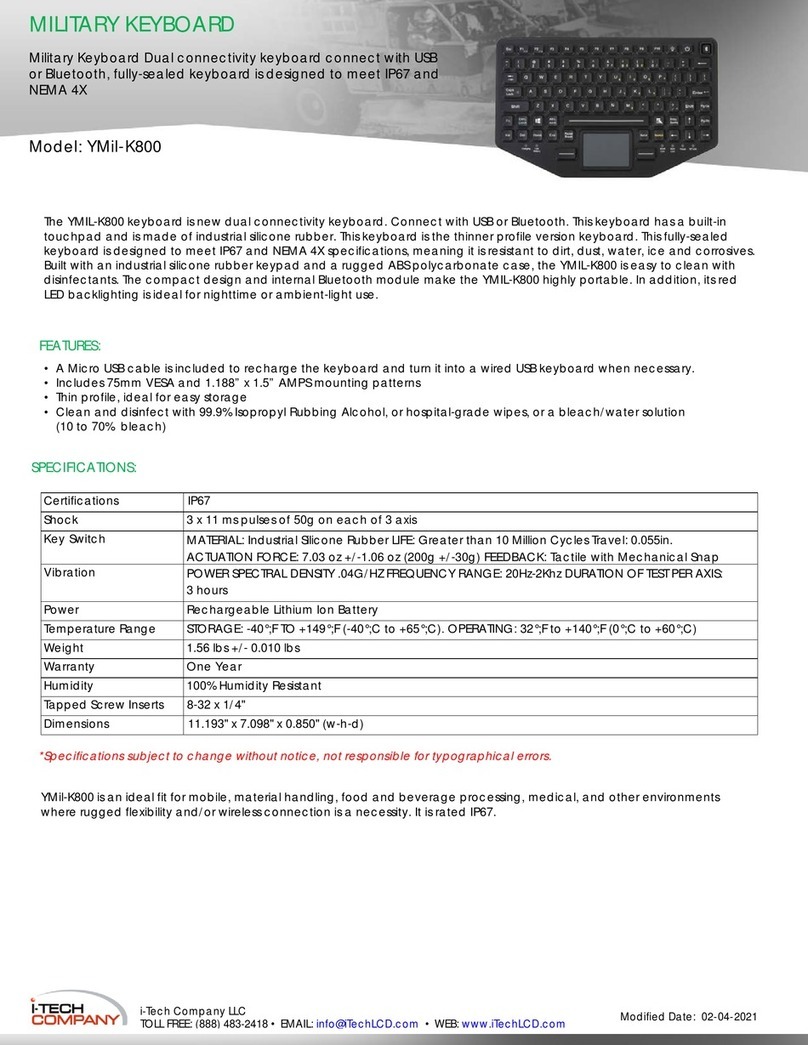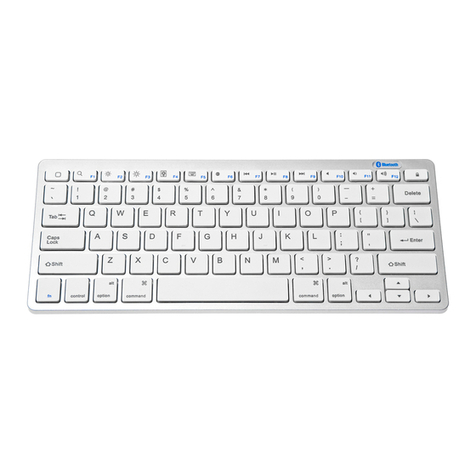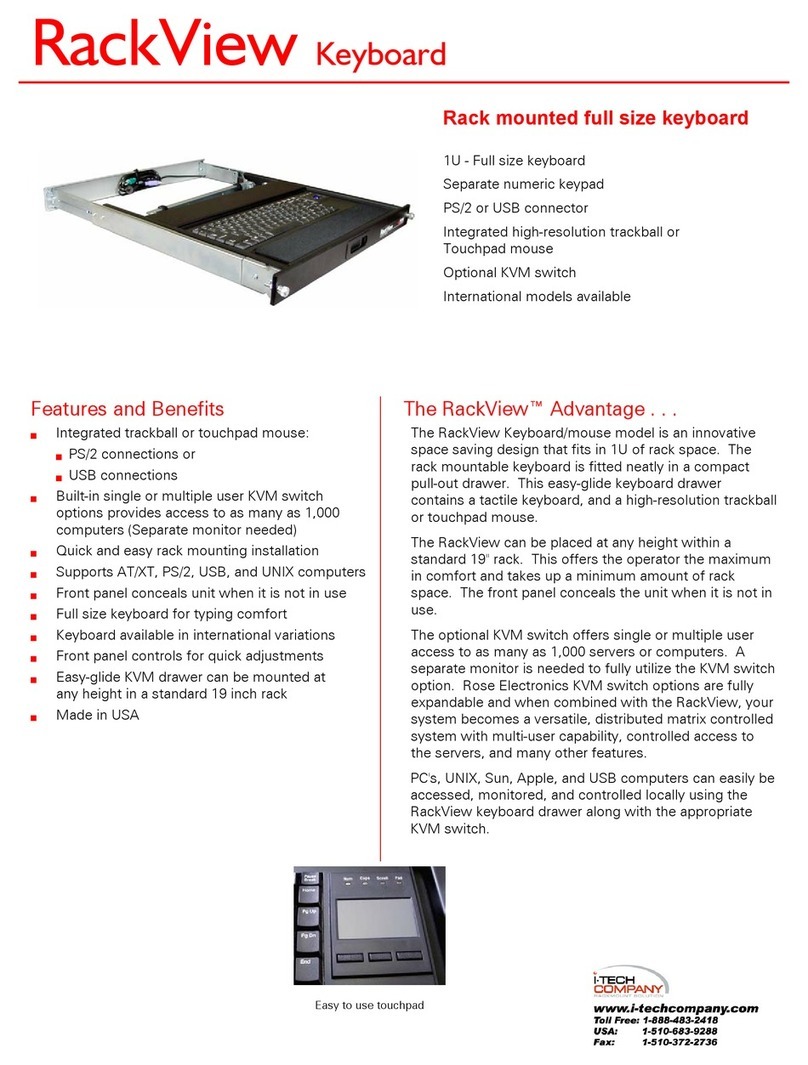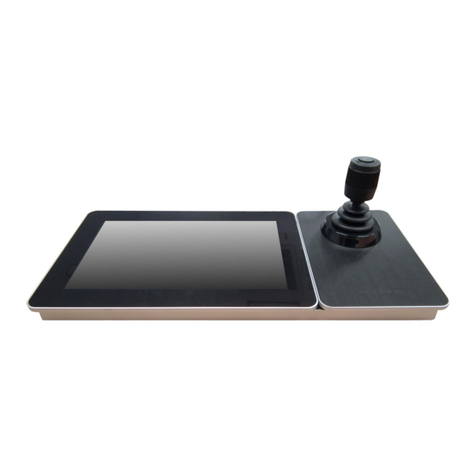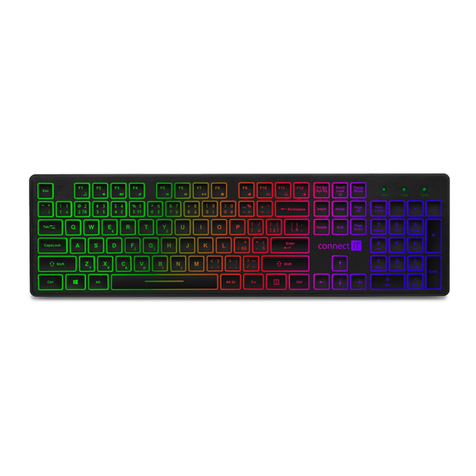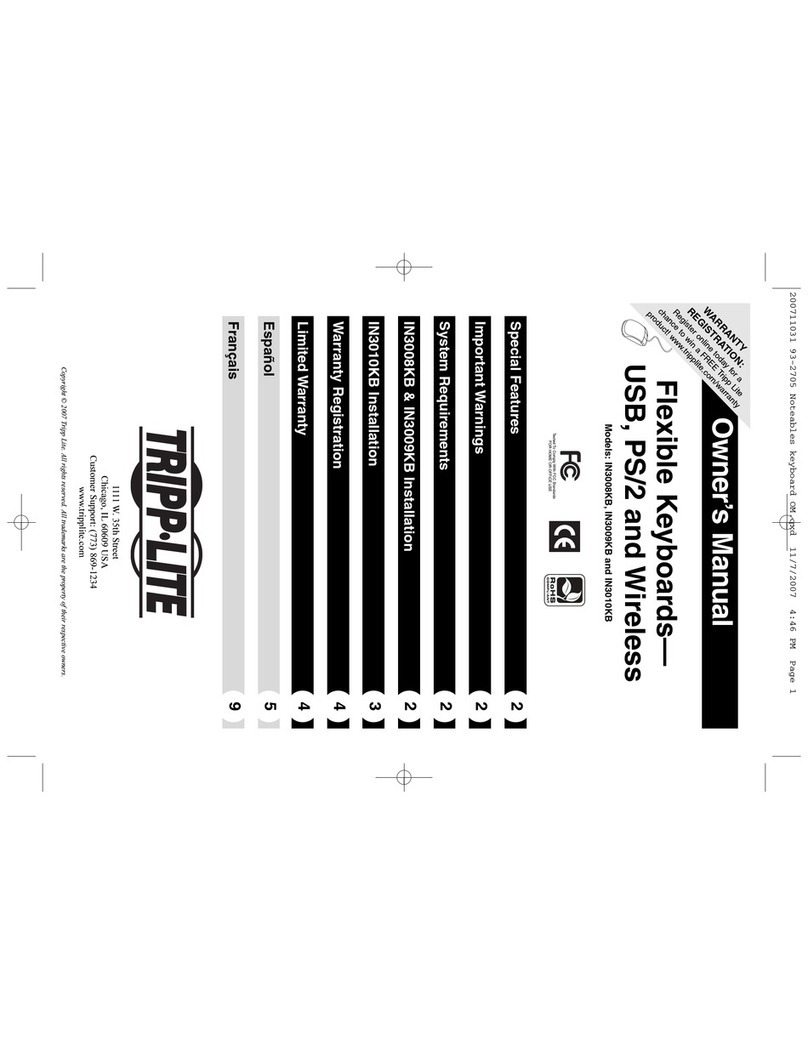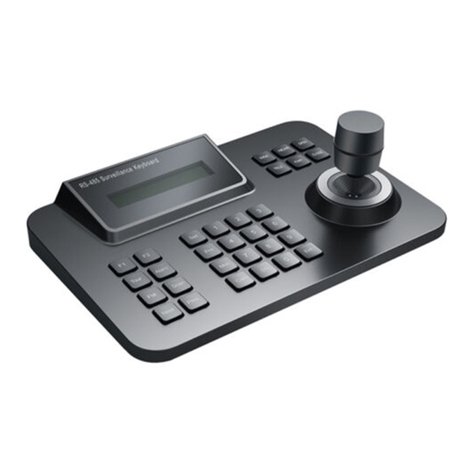E.L.B. TT-107IU Guide

B
EX-GERAETE
15.05.2012
TT
-
107IU
Technical Documentation

TT-107IU Silicone Keyboard - Technical Documentation
15.05.2012 © E.L.B. Ex-Geraete Bachmann GmbH Page 2
Operating Instructions
Contents
Page
1 In Short ..................................................................................................... 3
2 Delivery Components................................................................................ 3
3 Handling Hints........................................................................................... 3
4 Marking for Hazardous areas.................................................................... 6
5 Intrinsic Safe Supply and Data Transmission............................................ 7
Order examples.....................................................................................7 - 8
6 General Data
6.1 Current Consumption.................................................................... 8
6.2 Weights and measures................................................................. 8
6.3 IP Degree...................................................................................... 8
6.4 Extension Cables.......................................................................... 9
6.5 Connectors in Hazardous Areas................................................... 9
Appendix
7 Safety Advices .........................................................................................10
8 Liability.....................................................................................................11
9 Declaration of Conformity.........................................................................11
10 Certificate.................................................................................................12

TT-107IU Silicone Keyboard - Technical Documentation
15.05.2012 © E.L.B. Ex-Geraete Bachmann GmbH Page 3
General Information
1 In short
Advantages of the keyboard TT-107IU:
•Suitable for hazardous areas zone 1, 2 (gas), 21 and 22 (dust)
•Integrated mouse pad with special functions
•USB device; one cable only for keyboard and mouse
•Well palpable keys, easy to find even with gloves
•Switch point easy to feel
•Case without gaps and edges, easy to clean
•Case, lead and plug (silicone) resistant against most chemical fluids
•Dust and water proof, e.g. IP 68 (immersion)
•Suitable intrinsically safe interface and supply available (W...-Q)
2 Delivery components
Delivery includes:
-Keyboard TT-107IU (available in black only)
-Manual
3 Handling hints
Installation
Keyboard and mouse pad install themselves automatically on your PC as
“HIDs” (human interface devices). There is no driver CD necessary. Further-
more the USB plug may be connected before or after starting the PC.
With every powering-up the keyboard first checks the maximum possible data
rate of the USB channel. If the data rate is less than 480 Mbit/s (USB 2.0,
“high speed“) a message appears on the screen like this: “This device might
work better with a high-speed USB connector”, and the keyboard switches
back to 12 Mbit/s (USB 1.1 “full speed“). Actually this does not slow down the
data rate, because “full speed” is sufficient by far. Frequency testing and
message are just parts of standard routines, which can also be found in slow
USB devices.
The reason for this message may be a long cable or an intrinsically safe
supply connected with the keyboard. In both cases capacitances between the
cable leads or of protective diodes disturb the transmission of high
frequencies. However, when the message “Device not recognized” appears,
even USB 1.1 “full speed” cannot be achieved or there is another failure.

TT-107IU Silicone Keyboard - Technical Documentation
15.05.2012 © E.L.B. Ex-Geraete Bachmann GmbH Page 4
Handling of the mouse pad
The mouse pad detects the position of a finger by capacitance scanning. This
works even with rubber-gloves for single use, but not with usual working
gloves. If you cannot do without working gloves, please help yourself with a
metal tool with a big and flat bottom, covered by a sticking tape to protect the
mouse pad from being scratched. Additionally the electrical capacitance
between this tool and the environment
must be sufficient (big
overall surface). E. g.
the tubes of big felt-tip
pens are suitable (15
mm Ø, 100 mm length).
Mouse key functions
The mouse keys are situated between the mouse pad and the keyboard edge
close to the user. They work just like usual mouse keys.
Mouse pad functions
Sliding of one finger over the pad moves the mouse
pointer over the screen. Please read about additional
functions, which you might initiate by mistake.
1. Tapping on the pad - in general
No powerful knocking necessary. Just lay down your finger(s) gently on the
pad surface, without hurry while double-clicking.
2. Tapping on the pad - with one finger
a) Tapping once
Tapping once on the pad with one finger works like clicking the left mouse
button once: In text documents the text cursor jumps into the line of the
mouse pointer or a drawing is selected.
b) Tapping two or three times
Double tapping with one finger works like double-clicking of the left mouse
button. In text documents ...
•... the text cursor either jumps to the tab position, which is next to the
mouse pointer (behaviour at the end of a paragraph)
•... or a new tab is created at the mouse pointer position (behaviour
inside of a text line)
•... or the tapped word is selected.
Tapping three times selects the whole paragraph around the tapped word.
The fourth tapping cancels all former selections.

TT-107IU Silicone Keyboard - Technical Documentation
15.05.2012 © E.L.B. Ex-Geraete Bachmann GmbH Page 5
3. Sliding over the mouse pad - with one finger
a) Inside of the pad area
Sliding of one finger over the mouse pad moves the mouse pointer like
moving of a usual mouse does.
b) Along the right mouse pad edge
Sliding of one finger along the right mouse pad edge moves the screen
through you document like turning of a mouse wheel does.
4. Tapping on the mouse pad - with two fingers: mouse-wheel button
Tapping or laying down two fingers on
the mouse pad switches the soft-scroll
function on like pushing the mouse
wheel button. The mouse pointer
converts into two double arrowheads.
The black upper double arrowhead
can be moved away from the lower
grey one by sliding one finger over the
mouse pad surface like moving of a
mouse with mouse wheel. When the black double arrow converts into a
single pointer the screen starts to move over the document in the pointed
direction. The scroll velocity corresponds to the distance between the
arrowheads and the pointer.
Scrolling continues with no finger on the pad. Putting a finger on the pad
and sliding again may change the scroll velocity and direction. Two fingers
on the pad (= pressing the mouse wheel button) or only one (= ESC) stops
the scrolling and all arrows disappear.
5. Tapping on the mouse pad - with three fingers
Tapping with three fingers works like a right mouse button click.
6. Tapping on the mouse pad - by mistake
On this very compact keyboard a finger or the palm may sometimes touch
the mouse pad unintentionally. This might move the text cursor to the
mouse pointer position, where all further characters will appear. In most of
the word-processing programs the last text string can be erased by the
“Undo”-function = STRG+Z. Or the text string can be selected, cut out
(STRG+C) and inserted (STRG+V).
Stillstand Übergang ... Rollen
zum ...

TT-107IU Silicone Keyboard - Technical Documentation
15.05.2012 © E.L.B. Ex-Geraete Bachmann GmbH Page 6
4 Marking for Hazardous Areas
-Model designation: TT-107IU
-Marking for gas atmospheres: II 2 G Ex ib IIC T4
-Marking for dust atmospheres: II 2 D Ex ibD 21 T95°C
-Ambient temperatures: -20°C < T
amb
< +60°C
-Certificate no.: IBExU 11 ATEX 1016
Meanings of the markings:
5 Intrinsically Safe Supply and Data Transmission
Electrical values of the keyboard TT-107IU:
-maximum input voltage: U
i
≤5.9 V
-maximum supply current: I
i Supply
≤500 mA
-maximum data line input current: I
i Data
≤85 mA / line
-maximum supply power: P
i Supply
≤2.3 W
-maximum data line input power: P
i Data
≤0.5 W / per line
-maximum inner total capacitance: ΣC
i
≤40 µF
-maximum inner total inductivity: ΣL
i
≤1 µH
TT-107IU must be supplied by an ATEX certified intrinsically safe supply,
which fits to the electrical data listed above. This is
valid for the dust atmosphere models too. We
recommend the USB-supply series W...-Q,
which is meant for operating inside of gas
hazardous areas.
In dust atmosphere however USB sockets are not allowed, because the contacts are not dust
protected. (Danger of ignition of conductive dust.)
II 2 G Ex ib IIC T4 II 2 D Ex ibD 21 T95°C
Group II = no mining
Category 2 = zone 1 (frequent or
long lasting danger)
Gas atmosphere
i = intrinsically safe,
b = one-failure safety
Gas group (IIC = most severe
)
Class of surface temperature
during damage (T4: ≤135°C)
Group II = no mining
Category 2 = zone 1 (frequent or
long lasting danger)
Dust atmosphere
i = intrinsically safe,
b = one-failure safety
D = dust
Dust zone 21
Maximum surface temperature
during damage
Sign of the test board
Test year
Tested according to
ATEX standards
Certificate number
IBExU 11 ATEX 1016

TT-107IU Silicone Keyboard - Technical Documentation
15.05.2012 © E.L.B. Ex-Geraete Bachmann GmbH Page 7
Connection examples for supply by W...-Q
1. Gas areas
More information in the separate W...-Q manual.
Plugging and unplugging inside of hazardous gas areas is allowed because of
sufficiently low inner capacities.
2. Dust areas
USB sockets in dust atmosphere are not allowed, because the contacts are
not dust protected. (Danger of ignition of conductive dust.) But the keyboard
itself may be operated in dust areas:
Please find more connection possibilities in the USB sticks’ data sheets.
3. Order examples:
TT-107IU Intrinsically safe USB
keyboard with mouse pad
and ca. 2.1 m cable
WR-Q 005 A Intrinsically safe supply with
50 cm cable, flying leads
and attached USB plug
UClamp1 Connector for WR-Q 005 A
with clamping terminals
for the flying leads
Mounting example:
Safe area
PC
Hazardous area
Intrins. safe
supply
W...
-
Q
Keyboard
TT
-
107
IU
Safe area
PC
Hazardous
dust area
Intrins. safe
supply
W...-Q
Keyboard TT
-
107
IU

TT-107IU Silicone Keyboard - Technical Documentation
15.05.2012 © E.L.B. Ex-Geraete Bachmann GmbH Page 8
WR-Q 005 U Intrinsically safe supply with
50 cm cable and USB plug
moulded with the cable
USock1 Lockable built-in metal socket
for WR-Q 005; must be
isolated from metal
enclosure walls
USock2 Lockable built-in plastic socket
for WR-Q 005; does not need
to be isolated when mounted
in metal enclosure walls
6 General Data
6.1 Current consumption
•USB 2.0
1)
: max. ca. 140 mA
•USB 1.1
2)
: max. ca. 80 mA
•Standby
3)
: ca. 30 mA
1)
Connected directly with the PC without intrinsically safe supply
2)
With intrinsically safe supply between PC and keyboard
3)
After some period without operation
6.2 Weights and measures:
-Dimensions: 340 x 165 x 21.5 mm
-Weight: ca. 1200 g
-Cable length: ca. 2.1 m
Under the bottom plate there are four
nuts size M5 for fastening the key-
board to a desktop. They are covered
by stoppers or plastic screws. The
easiest way to remove the stoppers is
to pierce them with a screwdriver and
tilt them out.
6.3 IP degree: IP66/68
The marking may be IP66 and IP68 simultaneously, see certificate section
(15). So there are no different keyboard versions for special IP codes.
Meanings of the codes:
ca. 10 mm
Four nuts M5,
buried ca. 10 mm deep
75 mm
75 mm

TT-107IU Silicone Keyboard - Technical Documentation
15.05.2012 © E.L.B. Ex-Geraete Bachmann GmbH Page 9
IP6...: Dust proof, complete contact protection
IP...6: Tall seas / strong water beam
IP...8: Total immersion TT-107IU: 1 hour at 1 m below water surface
Wall thickness is generally more than 5 mm, but much less around the keys
and above of the lamps (under the keys “Num” and ““and between the keys
“Esc” and “1”). Even hardly visible damages may decrease the IP protection
here and make the dust protection become invalid. Please watch these areas.
6.4 Extension cables
USB plugs and sockets of USB cables are not allowed in hazardous areas, but
the leads of such cables may be connected in Ex e terminal blocks inside of
Ex e junction boxes (Ex e = kind of protection “increased safety”), if additional
rules for safe connections are watched. So the diameters of the usually thin
cable cores of USB and PS/2 cables e. g. must be increased by sleeves to
achieve the minimum diameters allowed for the terminal blocks. Measures can
be found in the certificates of the terminal blocks or the junction boxes.
The maximum cable length is not predictable, because many USB devices
refuse to install themselves, if the USB cable does not transmit frequencies,
which are much higher than the actual data transmission rate.
If you need especially long cables,
please give us a message.
The lead colours of USB cables are
standardized, see drawing.
For especially long cables
however we presume to use
different colours.
6.5 Connectors in hazardous areas
In hazardous dust environments USB plugs and sockets are not allowed,
because conductive dust could accumulate there
and catch fire by short circuiting contacts.
Inside of hazardous gas environments the
keyboard TT-107IU may be plugged
and unplugged, if it is supplied by
the intrinsically safe USB supply
series W...-Q, which have their
own manual. For these supplies
e. g. the lockable sockets
USock1and USock2are
available, see drawing.
Please note that USock1
connects the USB cable
shield with the plug thread.
+5V (red)
Data (white)
Clock (green)
GND (black)
USB socket
(PC or intrinsic safe supply)
USB plug
(keyboard)
+5V (red)
Data (white)
Clock (green)
GND (black)
Kabellänge zwischen Buchse
und Stecker ca. 50 cm

TT-107IU Silicone Keyboard - Technical Documentation
15.05.2012 © E.L.B. Ex-Geraete Bachmann GmbH Page
10
Appendix
7 Safety Advices
Keyboard surface
The silicone case wall is generally thicker than 5 mm, but much less around
the keys and above of the lamps (under the keys “Num” and ““and between
the keys “Esc” and “1”). Even hardly visible damages may decrease the IP
protection here and make the dust protection become invalid. Please watch
these areas.
Cleaning
only outside of hazardous areas because of possible charging of the cleaning
tool. No dry cleaning inside of hazardous areas.
In general
Read the manual completely and carefully before operation. Only the latest
documentation is valid.
If it can be assumed that safe operation is no longer possible, switch off the
unit and secure it against being used again.
Installation, maintenance and cleaning of the units must only be performed by
persons trained and authorized for this purpose, insofar as they are familiar
with the units.
It is prohibited for the operator or his staff to open the units in a way that is not
described in this manual. This may only be done by specifically authorized
personnel of E.L.B. Ex-Geraete GmbH & Co. KG.
Modifications and conversions to the units are not permissible and will cause
the Ex protection and the guarantee to become void.
E.L.B. Ex-Geraete GmbH & Co. KG is not liable for any consequential
damage.
The technical data specified for hazardous areas comply with the values
certified in the European Ex approval. The user bears the sole responsibility of
examining the equipment with regard to its suitability for the intended
application and environmental conditions. E.L.B. Ex-Geraete GmbH & Co. KG
accepts no liability for any lack of suitability.

TT-107IU Silicone Keyboard - Technical Documentation
15.05.2012 © E.L.B. Ex-Geraete Bachmann GmbH Page
11
8 Liability
The technical data specified for hazardous areas comply with the values
certified in the European Ex approval. The user bears the sole responsibility of
examining the equipment with regard to its suitability for the intended
application and environmental conditions. E.L.B. Ex-Geraete GmbH & Co. KG
accepts no liability for any lack of suitability.
9 Declaration of Conformity
EC Declaration of Conformity
We hereby confirm the conformity of the equipment listed below with the directives of the
Council of the European Community. The safety and installation instructions of the product
documentation must be observed.
Model: Silicone USB keyboard with mouse pad TT-107IU
Directive: EMC Directive 2004/108/EG
European Standards: EN 55022: 2008-07
EN 55024: 2003-10
Directive: Low Voltage Directive 2006/95/EC
European Standards: EN 60950: 2011-01
Directive: 94/9/EC
European Standards: EN 60079-0: 2009
EN 60079-11: 2007
EN 61241-11: 2006
(EN 61241-0 is part of EN 60079-0)
The certificate printed on the following pages relates to keyboards for zones 1 and 21 only.
For zone 2 and 22 E.L.B. Ex-Geraete Bachmann GmbH confirms on its own liability, that
their construction is identical with the devices for zones 1 and 21. The suitability for zones 21
and 22 is confirmed in the certificate chapter [16] on this condition.
E.L.B. Ex-Geräte Bachmann GmbH + Co.KG,
Postal address: An der Hartbruecke 8, 64625 Bensheim, GERMANY
Phone: ++49-6251-63736, Fax: ++49-6251-63729,
Company Reg.: HRA 23451
Manager: Steffen Bachmann

TT-107IU Silicone Keyboard - Technical Documentation
15.05.2012 © E.L.B. Ex-Geraete Bachmann GmbH Page
12
10 certificates

TT-107IU Silicone Keyboard - Technical Documentation
15.05.2012 © E.L.B. Ex-Geraete Bachmann GmbH Page
13

TT-107IU Silicone Keyboard - Technical Documentation
15.05.2012 © E.L.B. Ex-Geraete Bachmann GmbH Page
14
Table of contents

